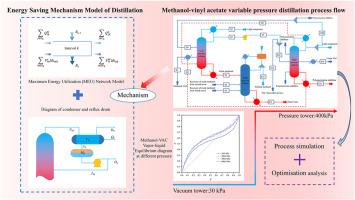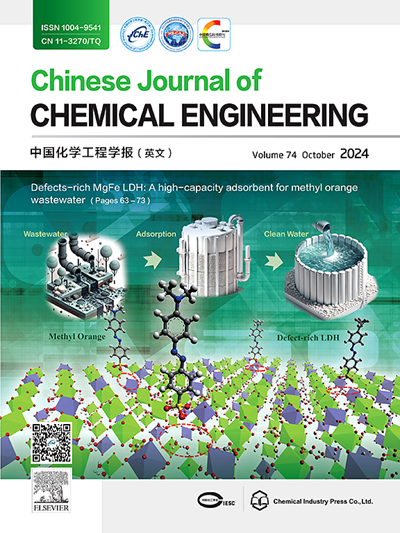基于变压精馏的甲醇-醋酸乙烯共沸物分离工艺优化及节能研究
IF 3.7
3区 工程技术
Q2 ENGINEERING, CHEMICAL
引用次数: 0
摘要
本文研究了变压蒸馏(PSD)技术对甲醇-醋酸乙烯酯(VAC)共沸物分离工艺的优化,并对其节能潜力进行了评价。甲醇-真空系统是一种极性共沸物,对压力变化非常敏感,在聚乙烯醇生产中呈现出明显的分离复杂性。利用Aspen Plus模拟来评估PSD的可行性,特别强调关键工艺参数,如理论板数、进料位置、回流比和侧流提取位置。结果表明,PSD对甲醇和VAC的分离效果显著,分离纯度分别达到99.88%和99.73%。与萃取精馏相比,PSD的蒸汽消耗量降低了9.07 t·h−1,废水产生量减少了20.77 t·h−1。此外,经济评估显示,与PSD相关的年度总成本降低了7.91%。本研究不仅为高效、可持续的分离工艺设计提供了理论依据,也为高效、可持续的分离工艺设计提供了实践指导。未来的研究将集中于扩展分析,以涵盖多压力情景,进一步提高研究结果的适用性和稳健性。本文章由计算机程序翻译,如有差异,请以英文原文为准。

Optimization of methanol–vinyl acetate azeotrope separation process based on the pressure swing distillation and energy saving study
This study delves into the optimization of the methanol–vinyl acetate (VAC) azeotrope separation process via pressure swing distillation (PSD), along with an evaluation of its energy-saving potential. The methanol–VAC system, a polar azeotrope highly susceptible to pressure variations, presents notable separation complexities in polyvinyl alcohol production. Aspen Plus simulations were utilized to assess the feasibility of PSD, with particular emphasis on critical process parameters such as the number of theoretical plates, feed position, reflux ratio, and sidestream extraction location. The results indicate that PSD demonstrates remarkable efficacy in separating methanol and VAC, achieving purities of 99.88% and 99.73% respectively. When compared to extractive distillation, PSD achieves a reduction of 9.07 t·h−1 in steam consumption and minimizes wastewater generation by 20.77 t·h−1. Furthermore, the economic assessment reveals a 7.91% decrease in the total annual cost associated with PSD. This study not only provides theoretical insights but also offers practical guidance for the design of energy-efficient and sustainable separation processes. Future research will focus on extending the analysis to encompass multi-pressure scenarios, further enhancing the applicability and robustness of the findings.
求助全文
通过发布文献求助,成功后即可免费获取论文全文。
去求助
来源期刊

Chinese Journal of Chemical Engineering
工程技术-工程:化工
CiteScore
6.60
自引率
5.30%
发文量
4309
审稿时长
31 days
期刊介绍:
The Chinese Journal of Chemical Engineering (Monthly, started in 1982) is the official journal of the Chemical Industry and Engineering Society of China and published by the Chemical Industry Press Co. Ltd. The aim of the journal is to develop the international exchange of scientific and technical information in the field of chemical engineering. It publishes original research papers that cover the major advancements and achievements in chemical engineering in China as well as some articles from overseas contributors.
The topics of journal include chemical engineering, chemical technology, biochemical engineering, energy and environmental engineering and other relevant fields. Papers are published on the basis of their relevance to theoretical research, practical application or potential uses in the industry as Research Papers, Communications, Reviews and Perspectives. Prominent domestic and overseas chemical experts and scholars have been invited to form an International Advisory Board and the Editorial Committee. It enjoys recognition among Chinese academia and industry as a reliable source of information of what is going on in chemical engineering research, both domestic and abroad.
 求助内容:
求助内容: 应助结果提醒方式:
应助结果提醒方式:


